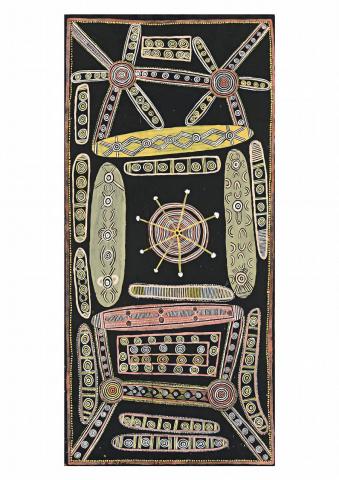WOMEN'S STORY, 1972
ANATJARI NO. III TJAKAMARRA
synthetic polymer powder paint on composition board
74.0 x 35.5 cm
inscribed verso: artist’s name ANATAR III, Stuart Art Centre consignment no. 12049, number 60 and the name Bardon
Executed at Papunya, 1972
Consignment 12, painting 49, Stuart Art Centre, Alice Springs
Private collection
Christie’s Tribal Art, South Kensington, London, 13 October 1992, Lot 276 (part)
Private collection, Melbourne
This work is accompanied by the original Stuart Art Centre certificate.
Described by Geoffrey Bardon as a man of wistful temperament, Anatjari Tjakamarra belonged to a group of men who arrived at Papunya after 1960 and were known as the ‘New Pintupi’.1 Along with Uta Uta Tjangala and Yala Yala Gibbs Tjungurrayi, Anatjari Tjakamarra was amongst the last of the desert dwelling Pintupi to be forced off their lands by the ‘Pintubi Patrols’ and consequently the least acculturated of the Papunya settlement. Resistant to assimilation and suffering ridicule as the ‘wild’ bush people, it wasn’t until the resurgence of interest in traditional culture which occurred in the late 1960s that the New Pintupi began to receive recognition as senior figures within the Papunya community.
In 1969 and early 1970s a series of trips were organised under the auspices of the then Australian Institute of Aboriginal Studies, with the intention of documenting ceremonies. Whilst withdrawn from circulation now, the first film, Pintubi Revisit Yumari, includes the participation of several men including Anatjari Tjakamarra who were to go on to become well-known painters in the Papunya movement, if not its founding figures. The filming trips represented an important opportunity for senior men to revisit their country and engage in the re-enactment of their Tjukurrpa, the effects of which were tangibly realised in their paintings of which Women’s Dreaming, 1972, is an important example.2
Recognised by Bardon as a painter of particular ability, by 1972 Tjakamarra was working with fine sable brushes and had a particular place of work in the Great Painting Room at Papunya. Along with Kaapa Tjampitjinpa, Tim Leura Tjapaltjarri and Johnny Warangkula Tjupurrula, Tjakamarra’s paintings from this time are recognised for their delicacy and celestial-like forms. Shown here in this work are groups of seated women with bullroarers and sacred objects, the entire composition oscillating around the central form, described on the accompanying Stuart Art Centre certificate as ‘headpiece of (a) very important corrobboree [sic] man’.
1. Bardon, G., and Bardon, J., Papunya, A Place made after the Story, The Mingunyah Press, Victoria, 2009, p. 7
2. Myers, F., and Long, J., in Perkins, H., One Sun, One Moon, Aboriginal Art in Australia, Art Gallery of New South Wales, Sydney, 2007, p. 174
MERRYN SCHRIEVER
